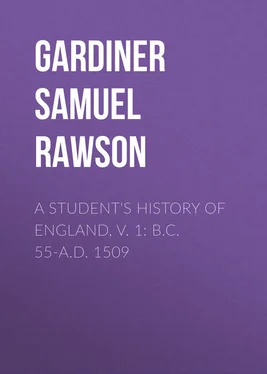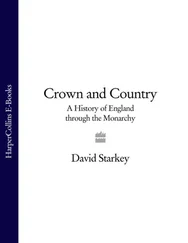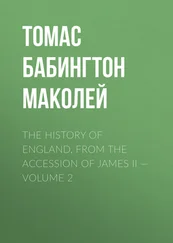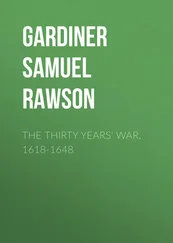Samuel Gardiner - A Student's History of England, v. 1 - B.C. 55-A.D. 1509
Здесь есть возможность читать онлайн «Samuel Gardiner - A Student's History of England, v. 1 - B.C. 55-A.D. 1509» — ознакомительный отрывок электронной книги совершенно бесплатно, а после прочтения отрывка купить полную версию. В некоторых случаях можно слушать аудио, скачать через торрент в формате fb2 и присутствует краткое содержание. Издательство: Иностранный паблик, Жанр: foreign_prose, История, foreign_antique, на английском языке. Описание произведения, (предисловие) а так же отзывы посетителей доступны на портале библиотеки ЛибКат.
- Название:A Student's History of England, v. 1: B.C. 55-A.D. 1509
- Автор:
- Издательство:Иностранный паблик
- Жанр:
- Год:неизвестен
- ISBN:нет данных
- Рейтинг книги:5 / 5. Голосов: 1
-
Избранное:Добавить в избранное
- Отзывы:
-
Ваша оценка:
- 100
- 1
- 2
- 3
- 4
- 5
A Student's History of England, v. 1: B.C. 55-A.D. 1509: краткое содержание, описание и аннотация
Предлагаем к чтению аннотацию, описание, краткое содержание или предисловие (зависит от того, что написал сам автор книги «A Student's History of England, v. 1: B.C. 55-A.D. 1509»). Если вы не нашли необходимую информацию о книге — напишите в комментариях, мы постараемся отыскать её.
A Student's History of England, v. 1: B.C. 55-A.D. 1509 — читать онлайн ознакомительный отрывок
Ниже представлен текст книги, разбитый по страницам. Система сохранения места последней прочитанной страницы, позволяет с удобством читать онлайн бесплатно книгу «A Student's History of England, v. 1: B.C. 55-A.D. 1509», без необходимости каждый раз заново искать на чём Вы остановились. Поставьте закладку, и сможете в любой момент перейти на страницу, на которой закончили чтение.
Интервал:
Закладка:
" "claimants of the Scottish throne 216
" "more important sons of Edward III. 265
" "claimants of the throne in 1399 286
" "kings of Scotland from Robert Bruce to James I. 295
" "Nevills 324
" "Houses of Lancaster and York 327
" "Beauforts and Tudors 335
" "House of York 337
" "Woodvilles and Greys 338
Abbreviated genealogy of Henry VII. and his competitors 344
Genealogy of the Houses of Spain and Burgundy 349
HISTORY OF ENGLAND
PART I.
ENGLAND BEFORE THE NORMAN CONQUEST
CHAPTER I.
PREHISTORIC AND ROMAN BRITAIN
Cæsar's first invasion B.C. 55
Invasion of Aulus Plautius A.D. 43
Recall of Agricola 84
Severus in Britain 208
End of the Roman Government 410
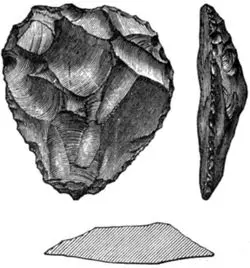
Palæolithic flint scraper from Icklingham, Suffolk. (Evans.)
1. Palæolithic Man of the River-Drift.—Countless ages ago, there was a period of time to which geologists have given the name of the Pleistocene Age. The part of the earth's surface afterwards called Britain was then attached to the Continent, so that animals could pass over on dry land. The climate was much colder than it is now, and it is known from the bones which have been dug up that the country was inhabited by wolves, bears, mammoths, woolly rhinoceroses, and other creatures now extinct. No human remains have been found amongst these bones, but there is no doubt that men existed contemporaneously with their deposit, because, in the river drift, or gravel washed down by rivers, there have been discovered flints sharpened by chipping, which can only have been produced by the hand of man. The men who used them are known as Palæolithic, or the men of ancient stone, because these stone implements are rougher and therefore older than others which have been discovered. These Palæolithic men of the river drift were a race of stunted savages who did not cultivate the ground, but lived on the animals which they killed, and must have had great difficulty in procuring food, as they did not know how to make handles for their sharpened flints, and must therefore have had to hold them in their hands.
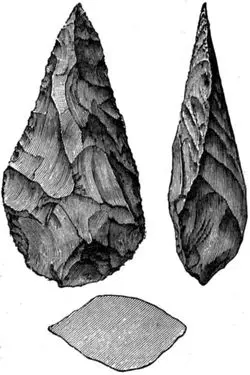
Palæolithic flint implement from Hoxne, Suffolk.
2. Cave-dwelling Palæolithic Man.—This race was succeeded by another which dwelt in caves. They, as well as their predecessors, are known as Palæolithic men, as their weapons were still very rude. As, however, they had learnt to make handles for them, they could construct arrows, harpoons, and javelins. They also made awls and needles of stone; and, what is more remarkable, they possessed a decided artistic power, which enabled them to indicate by a few vigorous scratches the forms of horses, mammoths, reindeer, and other animals. Vast heaps of rubbish still exist in various parts of Europe, which are found to consist of the bones, shells, and other refuse thrown out by these later Palæolithic men, who had no reverence for the dead, casting out the bodies of their relations to decay with as little thought as they threw away oyster-shells or reindeer-bones. Traces of Palæolithic men of this type have been found as far north as Derbyshire. Their descendants are no longer be met with in these islands. The Eskimos of the extreme north of America, however, have the same artistic faculty and the same disregard for the dead, and it has therefore been supposed that the cave-dwelling men were of the race to which the modern Eskimos belong.
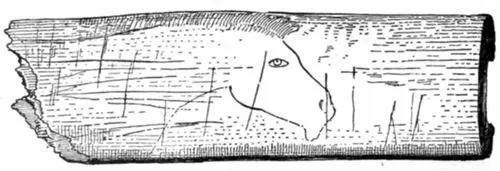
Engraved bone from Cresswell Crags, Derbyshire, now in the British Museum (full size).
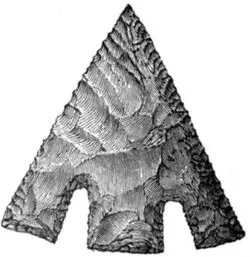
Neolithic flint arrow-head from Rudstone, Yorks. (Evans.)

Neolithic celt or cutting instrument from Guernsey. (Evans.)
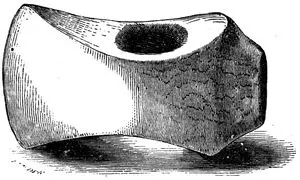
Neolithic axe from Winterbourn Steepleton, Dorset. (Evans.)
3. Neolithic Man.—Ages passed away during which the climate became more temperate, and the earth's surface in these regions sank to a lower level. The seas afterwards known as the North Sea and the English Channel flowed over the depression; and an island was thus formed out of land which had once been part of the continent. After this process had taken place, a third race appeared, which must have crossed the sea in rafts or canoes, and which took the place of the Palæolithic men. They are known as Neolithic, or men of the new stone age, because their stone implements were of a newer kind, being polished and more efficient than those of their predecessors. They had, therefore, the advantage of superior weapons, and perhaps of superior strength, and were able to overpower those whom they found in the island. With their stone axes they made clearings in the woods in which to place their settlements. They brought with them domestic animals, sheep and goats, dogs and pigs. They spun thread with spindle and distaff, and wove it into cloth upon a loom. They grew corn and manufactured a rude kind of pottery. Each tribe lived in a state of war with its neighbours. A tribe when attacked in force took shelter on the hills in places of refuge, which were surrounded by lofty mounds and ditches. Many of these places of refuge are still to be seen, as, for instance, the one which bears the name of Maiden Castle, near Dorchester. On the open hills, too, are still to be found the long barrows which the Neolithic men raised over the dead. There is little doubt that these men, whose way of life was so superior to that of their Eskimo-like predecessors, were of the race now known as Iberian, which at one time inhabited a great part of Western Europe, but which has since mingled with other races. The Basques of the Pyrenees are the only Iberians who still preserve anything like purity of descent, though even the Basques have in them blood the origin of which is not Iberian.
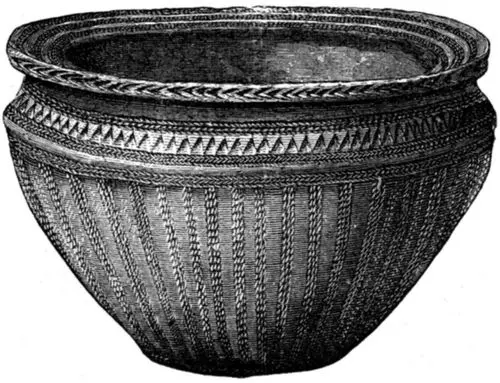
Early British Pottery.
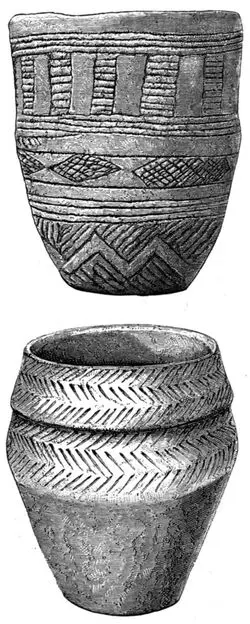
Early British Pottery.
4. Celts and Iberians.—The Iberians were followed by a swarm of new-comers called Celts. The Celts belong to a group of races sometimes known as the Aryan group, to which also belong Teutons, Slavonians, Italians, Greeks, and the chief ancient races of Persia and India. The Celts were the first to arrive in the West, where they seized upon lands in Spain, in Gaul, and in Britain, which the Iberians had occupied before them. They did not, however, destroy the Iberians altogether. However careful a conquering tribe maybe to preserve the purity of its blood, it rarely succeeds in doing so. The conquerors are sure to preserve some of the men of the conquered race as slaves, and a still larger number of young and comely women who become the mothers of their children. In time the slaves and the children learn to speak the language of their masters or fathers. Thus every European population is derived from many races.
Читать дальшеИнтервал:
Закладка:
Похожие книги на «A Student's History of England, v. 1: B.C. 55-A.D. 1509»
Представляем Вашему вниманию похожие книги на «A Student's History of England, v. 1: B.C. 55-A.D. 1509» списком для выбора. Мы отобрали схожую по названию и смыслу литературу в надежде предоставить читателям больше вариантов отыскать новые, интересные, ещё непрочитанные произведения.
Обсуждение, отзывы о книге «A Student's History of England, v. 1: B.C. 55-A.D. 1509» и просто собственные мнения читателей. Оставьте ваши комментарии, напишите, что Вы думаете о произведении, его смысле или главных героях. Укажите что конкретно понравилось, а что нет, и почему Вы так считаете.
